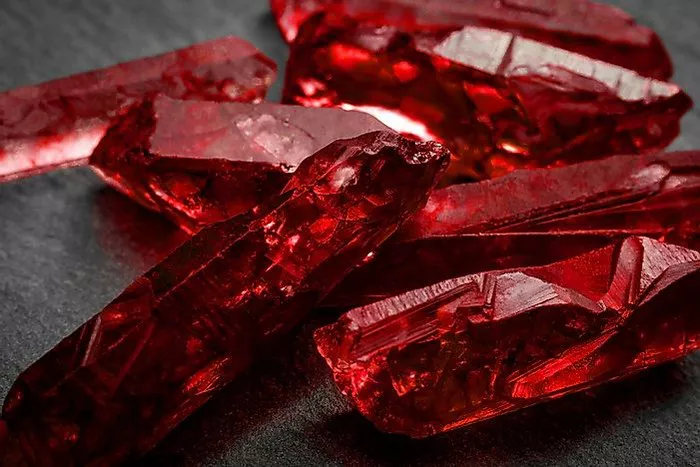Rubies, with their captivating deep red hues and illustrious history, have captivated humanity for centuries. These exquisite gemstones, known as the “King of Gems,” have adorned royal crowns, symbolized passion and power, and continue to be cherished for their undeniable beauty and rarity. But what lies beneath the polished and faceted surface of a ruby? In this article, we delve into the enchanting world of raw rubies, exploring their appearance, characteristics, and the natural wonders that contribute to their allure.
Origin and Formation of Rubies:
Raw rubies are formed deep within the Earth’s crust under intense heat and pressure. These precious gemstones belong to the corundum mineral family, which also includes sapphires. The mesmerizing red color of rubies is due to the presence of chromium within the crystal lattice structure during their formation process. Other trace elements, such as iron and titanium, can influence the shade and tone of the red hue.
Physical Appearance of Raw Rubies:
Raw rubies, in their uncut and untreated form, exhibit unique properties that distinguish them from their faceted counterparts. They typically appear as rough, irregularly shaped crystals with a range of colors, including pinkish red, purplish red, and deep blood-red. The size of raw rubies can vary significantly, from small pebble-like formations to larger pieces that can rival the size of a human fist.
Crystal Structure and Transparency:
Rubies crystallize in the hexagonal crystal system, forming long prismatic crystals or more compact granular aggregates. The crystal structure contributes to the gemstone’s durability and resistance to scratches, ranking just below diamonds on the Mohs scale of hardness. In their raw state, rubies may exhibit varying degrees of transparency, ranging from translucent to opaque.
Natural Inclusions and Clarity:
Raw rubies often contain natural inclusions, which are internal characteristics that provide glimpses into their formation journey. These inclusions can include mineral crystals, gas bubbles, or tiny fissures known as “silk.” Silk refers to needle-like rutile or hematite inclusions that intersect within the ruby, creating an effect called asterism—a star-like pattern visible when light is properly aligned. The presence of these inclusions adds uniqueness to each raw ruby, making them truly one-of-a-kind treasures.
Color and Hue Variations:
The color of a raw ruby can vary due to several factors, including the concentration and type of trace elements present during its formation. The most sought-after rubies exhibit a vibrant red color, often referred to as “pigeon blood red.” This hue is characterized by its deep crimson tone with a slight tint of blue. However, rubies come in various shades and hues, ranging from pinkish-red to purplish-red, and the market demand for specific hues varies depending on cultural preferences and trends.
Cutting and Polishing Techniques:
To transform raw rubies into the dazzling gemstones we commonly see in jewelry, lapidaries employ cutting and polishing techniques. Skilled artisans study each raw ruby’s shape, size, and internal inclusions to maximize its beauty and carat weight while minimizing any potential flaws. The cutting process involves carefully shaping the stone and faceting its surface to enhance its brilliance and fire—the ability to reflect and refract light.
Evaluating Raw Rubies:
Evaluating the quality and value of raw rubies requires considering multiple factors. The “Four Cs”—color, clarity, cut, and carat weight—play significant roles in determining a ruby’s worth. Color, particularly the intensity and saturation of red, is one of the most critical factors. Clarity refers to the presence or absence of inclusions, with fewer inclusions generally indicating higher quality. The cut determines how well the ruby interacts with light, affecting its brilliance. Finally, carat weight describes the size and mass of the gemstone.
Popular Deposits and Mining:
Rubies are found in various locations worldwide, with some regions renowned for producing exceptional specimens. Myanmar (formerly Burma) has historically been a significant source of high-quality rubies, including the famous “Mogok Valley” rubies. Other notable deposits can be found in Thailand, Sri Lanka, Madagascar, and Tanzania. Each region contributes distinct characteristics and qualities to the rubies it yields, making them geographically identifiable.
Conclusion:
Raw rubies offer a captivating glimpse into nature’s remarkable creations. From their formation deep within the Earth’s crust to their mesmerizing appearances in shades of red, raw rubies epitomize the wonders of natural artistry. Whether you cherish them for their aesthetic beauty or recognize their tangible value, raw rubies possess an enduring allure that has fascinated humanity for centuries. As you gaze upon the raw ruby, remember that within its uncut form lies a world of enchantment waiting to be discovered.
Related topics:
- Emerald and Ruby: Which Is More Expensive?
- What type of ruby is the most valuable: A Simple Guide
- What do raw rubies look like: A Quick Guide


